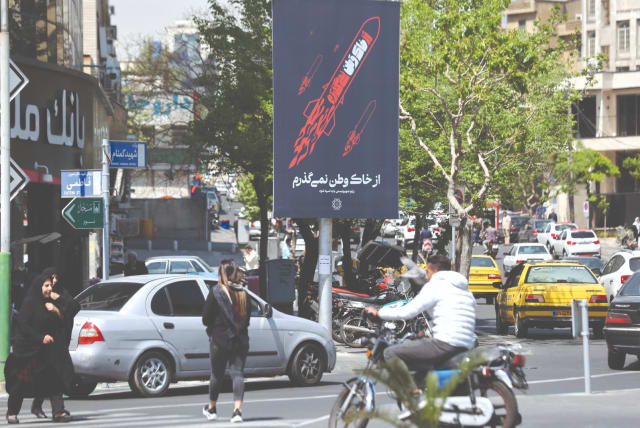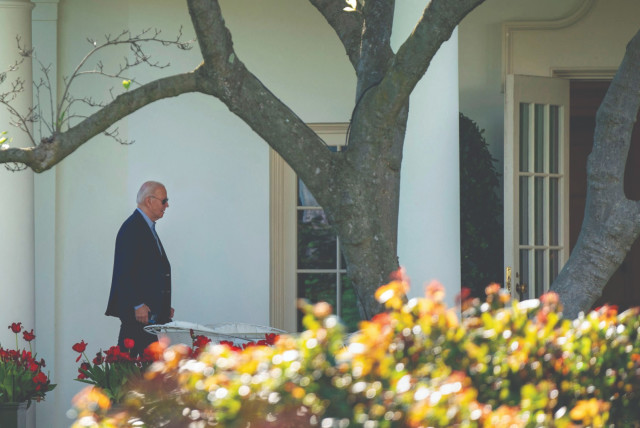It's no surprise that the Iranian regime doesn't heed America's warnings - opinion

After years of ineffectual diplomacy and cozying up to the Iranian regime, it should come as no surprise that when the president of the United States tells Iran not to attack, Iran will not listen.
On Saturday night, Israeli news erupted with reports that Iran had launched a direct attack on Israel. The long-anticipated attack came a day after US President Joe Biden issued a warning to Tehran in a Friday press conference, telling Iran: “Don’t” and declaring Washington’s commitment to supporting and defending Israel.
This statement of deterrence from America’s president was clearly ineffective, as Iran proceeded to send dozens of drones and cruise missiles into Israel less than 24 hours later.
Why did the president’s words have zero impact on the Islamic Republic’s plans, one might ask? The answer should be obvious to anyone who has been following American foreign policy not only during the Biden administration but also during the administration of his Democratic predecessor, Barack Obama.
The Obama administration ushered in an Iran policy characterized by alternating weakness and support, creating an American-Iranian relationship in which the country was enriched and emboldened rather than meaningfully dissuaded from causing chaos in the region. And the Biden administration picked up right where Obama left off, adopting a stance toward Iran that positioned it for today’s attack.
Just take the administration’s attempts to enact a new nuclear deal with the Iranians, in the spirit of the negotiations touted by the Obama regime as a historic accomplishment. The administration defended their spineless policy towards Iran by citing these negotiations, suggesting it was a temporary posture, and that if results weren’t coming soon, a tougher policy would soon emerge. But, as Michael Doran wrote in Tablet last year: “The Islamic Republic has, to name just a few developments, brutally suppressed the worst protests in its history, advanced its nuclear weapons program considerably, pursued plots to murder former American officials on American soil, and developed a defense industrial cooperation with the Russian military... None of these developments managed to try the patience of the Biden administration.”
This supine policy even applied to attacks on American forces, which received little to no retaliation. At a Senate hearing in 2023, Sen. Tom Cotton questioned Secretary of Defense Lloyd Austin about Iranian attacks, pointing out that Iran and Iran-backed militias had attacked American forces 83 times, and that the US had struck back only four times.
“What kind of signal do we think this sends to Iran?” asked Cotton at the time. Now, as Iran fires dozens of UAVs into Israel not even a day after Biden encouraged restraint, we see the answer to this question.
Biden administration's policy caveat with the Iranian regime
While most of Biden’s approach to the Islamic Republic was characterized by non-action, there is one notable exception: The administration certainly proved willing to make generous payments to the Iranian regime, in the form of sanctions relief and the unfreezing of funds. Outside observers were sounding the alarm about the dangers of sanctions relief as early as the Iran Deal in 2015, warning that the estimated $50 billion that Iran would gain access to through sanctions termination could and would likely be used to support terror activities in the region, funding militias like Hamas and Hezbollah.
Their warnings were prescient, as Iran proceeded to cultivate an axis of evil in the region by doing just this. The Islamic Republic’s obvious financial enmeshment with terrorist militias didn’t stop the Biden administration from freeing up $6 billion in funds to Iran, which the president said the country will spend “however they need it,” in September of 2023.
Even the terror attack by Hamas, Iran’s proxy, that occurred only two weeks after those funds were unfrozen, didn’t shake the administration from its approach to Iranian sanctions. Just weeks after the October 7 massacre, the Biden administration awarded sanctions waivers worth $10 billion to Iran, the obvious primary external sponsor of those attacks.
The weakness and folly of this policy would be laughable if it wasn’t an obvious – and now, urgent –danger. There is apparently no limit to the terror activity, whether it is aimed at Israelis, Americans, or the rest of the West, that the US will allow from Iran before it changes its course of supportive action. And not only has the Biden administration sat back and allowed Iran to wreak havoc on the region without penalty, but it has also openly emboldened and likely even funded some of these destructive activities by allowing billions of dollars to flood into the coffers of a clearly hostile foreign power.
In other words, after years of pathetically ineffectual diplomacy and cozying up to the Iranian regime, it should come as no surprise that the president of the United States now stands behind his podium telling Iran not to attack, and Iran does not listen.
Iran’s war on the West is not just Israel’s problem, it is and has always been America’s problem. We need a leader who recognizes and acts upon this, not a leader who can only offer empty words and spineless policy. Sadly, as the Middle East and the US now brace for what may well be an ugly regional conflict, the dangers of the man we’ve chosen have never been clearer.
The writer is a prominent Beverly Hills plastic surgeon, and star of the Emmy-nominated Netflix original series, Skin Decision: Before and After.
Jerusalem Post Store
`; document.getElementById("linkPremium").innerHTML = cont; var divWithLink = document.getElementById("premium-link"); if (divWithLink !== null && divWithLink !== 'undefined') { divWithLink.style.border = "solid 1px #cb0f3e"; divWithLink.style.textAlign = "center"; divWithLink.style.marginBottom = "15px"; divWithLink.style.marginTop = "15px"; divWithLink.style.width = "100%"; divWithLink.style.backgroundColor = "#122952"; divWithLink.style.color = "#ffffff"; divWithLink.style.lineHeight = "1.5"; } } (function (v, i) { });

